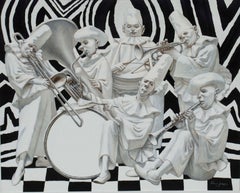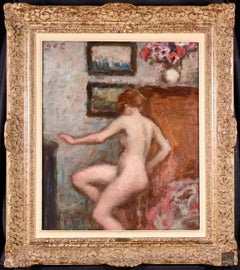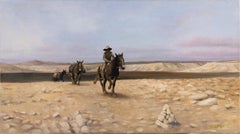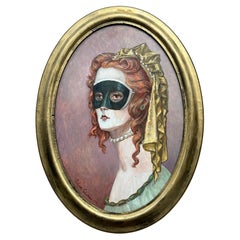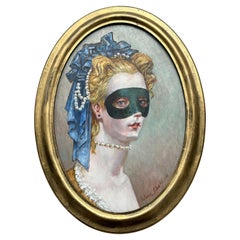Palmer Schoppe Art
to
1
1
Overall Width
to
Overall Height
to
2
1
1
1
1
2
2
1
1
1
1
1
1
2
2
1
1
2
9,962
2,753
1,376
1,373
1
2
Artist: Palmer Schoppe
'Woman Bathing', Chouinard, Yale, ASL, Los Angeles County Museum of Art, GGIE
By Palmer Schoppe
Located in Santa Cruz, CA
Signed lower right, 'Palmer Schoppe' (American, 1912-2001) and dated 1966.
Displayed in a gilt frame with a water-gilded, silver-gilt liner.
Framed dimensions: 27 H x 1.25 D x 23 W inches.
Born in Utah, Palmer Schoppe moved with his family to southern California in 1920 and settled in Santa Monica. Artistically inclined and precocious, he began painting as a child. After graduating from UCLA, he spent a year in the Merchant Marines before attending Yale School of Fine Arts and the Art Students League in New York. At the ASL, he was initially drawn to the paintings of Jean Charlot and Thomas Hart Benton but grew increasingly frustrated with their insistence on rigid compositional principles. His native artistic talents prevailed over his lack of formal training, however, and he was promptly employed by both the Chouinard Institute and Walt Disney Studios as a drawing instructor. During this pre-war period, he exhibited with success including at the Golden Gate International Exposition (1939) and with the California Watercolor Society.
Outside of his teaching responsibilities, he worked on his personal artistic endeavors and. like many artists of the time, focused primarily on figurative subject matter. Schoppe's early travels in the low country of South Carolina; Harlem, New York and Los Angeles informed his work as he sought to capture the regional life of manual laborers, musicians, circus performers, sun bathers and surfers. Schoppe once stated that, "It seems fairly certain that my work is not 'art about art', but art that is a reaction to a given stimulus. These are 'subject' pictures in that they are definitely in response to a certain place, type of people, cultures and customs".
Following his service in World War II, Schoppe returned to teaching at the Art Center College of Design in Pasadena, CA. He became increasingly disillusioned by the changing focus of the art world in the 1950s, when "the' drip' , the' blot', and the' isms' had taken over". He stated that, "it was difficult for the figurative painter to exhibit and I retired from the scene." However, a new artistic outlet presented itself when Schoppe began working as a muralist and architectural sculptor for the architect Aurthur Froelich, who designed race tracks and club houses around the country. This led to a proliferation of mural projects ranging from restaurants to scores of hotels and casinos, such as the Aladdin Hotel, Las Vegas; Circus-Circus, Las Vegas; the Queen Mary ship...
Category
1960s Palmer Schoppe Art
Materials
Canvas, Oil
Mardi Gras: Commedia Dell'Arte
By Palmer Schoppe
Located in West Hollywood, CA
Presenting a lifetime masterpiece painting by American artist Palmer Schoppe (1912-2001.)
Mardi Gras: Commedia Dell’Arte, is an original oil on can...
Category
1980s Realist Palmer Schoppe Art
Materials
Oil
Related Items
Nu avec des fleurs - Post-Impressionist Oil, Nude & Flowers - Georges D'Espagnat
By Georges d'Espagnat
Located in Marlow, Buckinghamshire
Signed nude oil on original canvas circa 1910 by French post impressionist painter Georges D'espagnat. The work depict a nude woman seated on a stall turned away from the artist. Paintings hang on the wall and there's a vase filled with pink and red flowers on the wooden mantlepiece beside her.
Signature:
Signed upper left
Dimensions:
Framed: 30"x26"
Unframed: 22"x18"
Provenance:
Private French collection.
Exhibition stamp verso
From the beginning of his career, it was a constant concern of Georges d'Espagnet to assert his originality. His studies at the École des Arts Décoratifs, Paris, did not last very long, for he wanted immediate independence and decided to follow courses in the private academies of Montparnasse. In about 1900, he became acquainted with Maurice Denis, Bonnard and Vuillard, and his collaboration with Denis led to a renewal of religious art in France.
In 1903, d'Espagnet was one of the founders of the Salon d'Automne, and was appointed professor in charge of studios at the École des Beaux-Arts, Paris, in 1934. He illustrated a number of books: Rémy de Gourmont's Evil Prayers ( Oraisons mauvaises) (1896), The Saints of Paradise ( Les Saintes du paradis) (1898), Simone (1907), Sistine ( Sixtine) (1922); Alphonse Daudet's The Immortal ( L'Immortel) (1930); André Gide's The Pastoral Symphony ( La Symphonie pastorale); Francis Jammes' Clearings in the Sky ( Chairières dans le ciel) (1948).
D'Espagnet belongs to the group of artists who made the Courrier Français so successful. The drawings of his which are published in it are strongly expressive and some bear comparison with the designs of the great Renaissance masters. He also contributed to L'Image. He often placed cheerful nudes in a landscape, reminding us that, though he moved away from the Fauves, he retained their freedom of colour and arabesque. He painted many portraits, including those of Albert André, André Barbier...
Category
1910s Post-Impressionist Palmer Schoppe Art
Materials
Canvas, Oil
Robert Kenneth White "Cairn Road" Signed Realist Oil, Western Desert Landscape
Located in Miami, FL
ROBERT KENNETH WHITE – "CAIRN ROAD"
⚜ Oil on Canvas ⚜ Hand Signed Lower Right ⚜ Frameless Display
A QUIET TESTAMENT TO ENDURANCE AND SOLITUDE
In “Cairn Road” (2012), Robert Kenneth ...
Category
2010s Realist Palmer Schoppe Art
Materials
Canvas, Oil
$1,980 Sale Price
44% Off
H 20.125 in W 36.125 in D 0.875 in
'Young Man in Repose' by Podlach - Large Male Intimate Figurative Nude Painting
By Betsy Podlach
Located in Carmel, CA
Betsy Podlach (American, born 1964)
"Young Man in Repose" 2009
Oil Paint, Canvas, Stretcher Bars
The artist signed the back of the painting.
"Young Man in Repose" is a captivating p...
Category
2010s Fauvist Palmer Schoppe Art
Materials
Canvas, Oil, Stretcher Bars
$14,750
H 58 in W 58 in D 1.5 in
Coastal Seascape Landscape Painting with Boats by 20th Century French Artist
By Pierre de Clausade
Located in Preston, GB
Coastal Seascape Landscape Painting with Boats by 20th Century French Artist, Pierre de Clausade (1910-1976).
Oil on canvas, Signed on the lower ...
Category
20th Century Realist Palmer Schoppe Art
Materials
Canvas, Paint, Cotton Canvas, Oil
Pierre de ClausadeCoastal Seascape Landscape Painting with Boats by 20th Century French Artist, 1972
$6,475 Sale Price
20% Off
H 24 in W 27.5 in D 2 in
Cherubs
By George Henry Hall
Located in Wilton Manors, FL
George Henry Hall (1825-1913). Cupids, 1875. Oil on canvas, 6 x 9.25 inches; 10 x 13.25 inches framed. Original frame with label verso. Excellent condition with no damage or restoration. Signed and dated lower right.
Price on request
Biography:
Birth place: Manchester, NH
Addresses: Primarily in NYC from 1852
Profession: Still-life, genre, portrait painter
Studied: between 1849-52 in Paris and Rome; and Düsseldorf Royal Acad. with Eastman Johnson
Exhibited: PAFA, 1853-68; Royal Acad., British Inst., Suffolk Street Gal., all in London, 1858-74; Brooklyn AA, 1861-81; NAD, 1862-1900; AIC, 1888; Boston AC, 1881, 1889
Member: ANA, 1853; NA, 1868; Century Assn.
Work: MMA; BM; BMFA
Comments: Best known for his still-lifes, he specialized in detailed and vividly colored fruit and flower...
Category
19th Century Realist Palmer Schoppe Art
Materials
Canvas, Oil
Ballerinas, cardboard/oil, 33x41 cm, 1997
Located in Riga, LV
Born in Republic of Georgia, Serguei Zlenko graduated first from the Russian Art Academy’s Art School, and later received a Bachelor and Masters of Fine Art from the Moscow Surikov A...
Category
1990s Realist Palmer Schoppe Art
Materials
Oil, Cardboard
$1,711 Sale Price
20% Off
H 13 in W 16.15 in D 1.19 in
"Glimmer" (2024) Oil Painting by Karen Offutt, Nude Female Portrait
By Karen Offutt
Located in Denver, CO
Karen Offutt's (US based) "Glimmer" is an original, handmade oil painting that depicts a nude female wearing a translucent robe, posing with her arms above her head. The painting is ...
Category
21st Century and Contemporary Realist Palmer Schoppe Art
Materials
Oil, Panel
$3,000
H 16 in W 12 in D 0.25 in
Nude of Klaudia from One Side - Oil Paint by Marco Fariello - 2021
Located in Roma, IT
Nude of Klaudia from one side is one of the best works by the artist Marco Fariello. It is made on canvas, painted in oil in 2021.
The subject of the work is the representation of a...
Category
21st Century and Contemporary Contemporary Palmer Schoppe Art
Materials
Canvas, Oil
$2,377
H 35.44 in W 15.75 in D 0.04 in
Nude - Figurative Oil Realistic painting, Polish young artist
Located in Warsaw, PL
AGNIESZKA STAAK-JANCZARSKA (born in 1994)
A graduate of the State Secondary School of Art of Józef Kluza in Krakow. In 2020, she graduated from the Academy of Fine Arts in Krakow in ...
Category
2010s Naturalistic Palmer Schoppe Art
Materials
Canvas, Oil
$2,377 Sale Price
20% Off
H 35.44 in W 35.44 in
Girls Just Wanna Have Fun 6 - Contemporary Figurative Oil Painting, Sea View
By Julita Malinowska
Located in Salzburg, AT
Artodyssey
"Julita Malinowska's paintings belong to those, which once seen - are never forgotten. The open spaces, sometimes cool and bright, at other times heavily saturated with co...
Category
2010s Realist Palmer Schoppe Art
Materials
Canvas, Oil
$6,472
H 39.38 in W 27.56 in D 0.79 in
The Walk - Contemporary Figurative Oil Painting, Sea, Beach View, Realism, Woman
By Julita Malinowska
Located in Salzburg, AT
Artodyssey
"Julita Malinowska's paintings belong to those, which once seen - are never forgotten. The open spaces, sometimes cool and bright, at other times heavily saturated with co...
Category
2010s Photorealist Palmer Schoppe Art
Materials
Canvas, Oil
$6,894
H 59.06 in W 27.56 in D 0.79 in
"Late Afternoon Taos Pueblo, " Southwestern Landscape Oil Painting
By Lorenzo Chavez
Located in Denver, CO
"Late Afternoon Taos Pueblo" by Lorenzo Chavez (US based) is a handmade oil painting that depicts a rural road around the old Taos Pueblo.
“Late Afternoon Taos Pueblo” I love explo...
Category
21st Century and Contemporary Realist Palmer Schoppe Art
Materials
Oil
Previously Available Items
Masked Women #1, Oval Oil Portrait in a Gold Frame by Palmer Schoppe
By Palmer Schoppe
Located in Pasadena, CA
"Masked Woman", 1991 – Palmer Schoppe
A haunting portrait of mystery, elegance, and timeless femininity
With Masked Woman, dated 1991, Palmer Schoppe delivers a captivating homage t...
Category
1990s Baroque Palmer Schoppe Art
Materials
Oil
H 22.5 in W 16.5 in D 1.5 in
"Masked Woman #2", Oval Portrait on Oil in a Gold Frame by Palmer Schoppe
By Palmer Schoppe
Located in Pasadena, CA
In Masked Woman (1991), Palmer Schoppe presents a figure who is at once distant and magnetic — a woman shrouded in mystery, yet rendered with striking intimacy. This oval portrait, r...
Category
1990s Baroque Palmer Schoppe Art
Materials
Oil
H 22.5 in W 16.5 in D 1.5 in
The White Clown
By Palmer Schoppe
Located in Los Angeles, CA
THE WHITE CLOWN
OIL ON CANVAS, SIGNED
C.1960
28 X 28 INCHES
Palmer Schoppe
1912-2001
Schoppe was born in Woods Cross, Utah on April 2, 19...
Category
American Modern Palmer Schoppe Art
Materials
Canvas, Oil
Silver Shawl
By Palmer Schoppe
Located in Los Angeles, CA
Palmer Schoppe was born on April 2, 1912 to parents who managed his grandfather's orchards and alfalfa fields in Woods Cross, Utah. He was praised early on for his natural artistic aptitude and determined to pursue the career of an artist. Encouraged by his parents to obtain an academic degree he attended UCLA and Yale for a period of time before enrolling at the Art Student's League of New York. He was compelled by the paintings of Jean Charlot, an artist and instructor at the League, but soon grew disillusioned by the strict compositional theories of instructors Charlot and Thomas Hart Benton. However, Schoppe's artistic talents prevailed over his lack of formal training and he was hired by the Chouinard Institute and Walt Disney Studios in the 1930s as a drawing instructor.
Outside of teaching, he worked on his personal artistic endeavors and like many artists of the time focused on figurative subject matter. Schoppe's early travels in the low country of South Carolina; Harlem, New York and Los Angeles, California informed his paintings as he captured the regional life of manual laborers, musicians, circus performers, sun bathers and surfers. Schoppe once stated that, "It seems fairly certain that my work is not 'art about art', but art that is a reaction to a given stimulus. These are 'subject' pictures in that they are definitely in response to a certain place, type of people, cultures and customs".
Following a period of service in World War II, Palmer Schoppe returned to teaching at the Art Center College of Design in Pasadena, CA. He became increasingly disillusioned by the changing focus of the art world in the 1950s, when "the' drip' , the' blot', and the' isms' had taken over". He stated that, "it was difficult for the figurative painter to exhibit and I retired from the scene." However, a new artistic outlet presented itself when Schoppe began working as a muralist and architectural sculptor for the architect Aurthur Froelich, who designed race tracks and club houses around the country. This led to a proliferation of mural projects ranging from restaurants to scores of hotels and casinos, such as the Aladdin Hotel, Las Vegas; Circus-Circus, Las Vegas; the Queen Mary ship...
Category
1980s Modern Palmer Schoppe Art
Materials
Canvas, Oil
Side Show
By Palmer Schoppe
Located in Los Angeles, CA
SIDE SHOW
OIL ON CANVAS, SIGNED
C.1990
27 X 18 INCHES
Palmer Schoppe
1912-2001
Schoppe was born in Woods Cross, Utah on April 2, 1912, Palmer Schoppe moved with his family to southern California in 1920 and settled in Santa Monica.
Artistically inclined, he began painting when quite young. He was educated at UCLA and, following one year in the Merchant Marines, he attended Yale School of Fine Arts and the ASL in NYC.
After returning to Los Angeles in 1934, he produced lithographs and abstract watercolors of the black people of South Carolina's low country and jazz musicians. Schoppe taught at the Disney Studio Training School (1934-37), Chouinard Art Institute (1935-42), Art Center School (1945-53), and USC Film Dept (1954-76).
Palmer Schoppe was one of the group of artists who participated in the cultural flowering of the 1920s through 1940 that is called the Charleston Renaissance. In his choice of subjects and of media (lithographs and paintings) Schoppe contributed to a nationwide interest in Lowcountry life and culture.
Schoppe visited Charleston and nearby sea islands in 1934. He was an acquaintance of Dubose Heyward, Alfred Hutty...
Category
1980s Modern Palmer Schoppe Art
Materials
Canvas, Oil
Palmer Schoppe art for sale on 1stDibs.
Find a wide variety of authentic Palmer Schoppe art available for sale on 1stDibs. You can also browse by medium to find art by Palmer Schoppe in oil paint, paint and more. Not every interior allows for large Palmer Schoppe art, so small editions measuring 50 inches across are available. Customers who are interested in this artist might also find the work of John McCormick, Catherine Koenig, and A.D. Greer. Palmer Schoppe art prices can differ depending upon medium, time period and other attributes. On 1stDibs, the price for these items starts at $25,000 and tops out at $25,000, while the average work can sell for $25,000.

